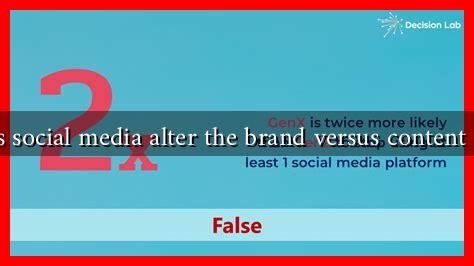-
Table of Contents
How Does Social Media Alter the Brand Versus Content Landscape?
In the digital age, social media has become a powerful tool that reshapes how brands communicate with their audiences. The interplay between brand identity and content creation has evolved significantly, leading to new strategies and challenges for marketers. This article explores how social media alters the brand versus content landscape, highlighting key trends, examples, and insights.
The Shift in Brand Communication
Traditionally, brands relied on one-way communication methods, such as television ads and print media, to convey their messages. However, social media has transformed this dynamic into a two-way conversation. Brands now engage directly with consumers, allowing for real-time feedback and interaction.
- Increased Engagement: Social media platforms enable brands to interact with their audience through comments, shares, and likes, fostering a sense of community.
- Authenticity and Transparency: Consumers expect brands to be genuine. Social media allows brands to showcase their values and mission, building trust with their audience.
- Real-Time Feedback: Brands can quickly gauge consumer reactions to their campaigns, allowing for immediate adjustments and improvements.
The Rise of Content Marketing
Content marketing has gained prominence as brands seek to provide value beyond traditional advertising. Social media serves as a platform for distributing this content, making it essential for brands to create high-quality, engaging material.
- Storytelling: Brands are increasingly using storytelling techniques to connect emotionally with their audience. For example, Nike’s “Just Do It” campaign not only promotes products but also inspires consumers to pursue their goals.
- Educational Content: Brands like HubSpot and Buffer provide valuable resources and insights, positioning themselves as industry leaders while attracting potential customers.
- Visual Content: Platforms like Instagram and TikTok emphasize visual storytelling, prompting brands to invest in high-quality images and videos to capture attention.
Case Studies: Brands That Excel in Social Media
Several brands have successfully navigated the social media landscape, demonstrating the power of effective content strategies.
- Wendy’s: Known for its witty and humorous Twitter presence, Wendy’s engages with customers through playful banter, which has significantly increased its brand visibility and customer loyalty.
- GoPro: By encouraging users to share their adventure videos, GoPro has built a community of brand advocates. Their user-generated content strategy showcases the product’s capabilities while fostering a sense of belonging among users.
- Airbnb: Through compelling storytelling and user-generated content, Airbnb has created a platform that highlights unique travel experiences, effectively positioning itself as more than just a rental service.
The Challenges of Social Media for Brands
While social media offers numerous opportunities, it also presents challenges that brands must navigate carefully.
- Negative Feedback: The open nature of social media means that negative comments can spread quickly. Brands must be prepared to address criticism transparently and constructively.
- Content Saturation: With countless brands vying for attention, standing out in a crowded marketplace requires creativity and innovation.
- Algorithm Changes: Social media platforms frequently update their algorithms, affecting how content is distributed. Brands must stay informed and adapt their strategies accordingly.
Conclusion: The Future of Brands and Content in Social Media
Social media has fundamentally altered the brand versus content landscape, creating a more interactive and dynamic environment. Brands that embrace this change by prioritizing engagement, authenticity, and high-quality content will thrive in the digital age. As the landscape continues to evolve, staying adaptable and responsive to consumer needs will be crucial for success.
In summary, the relationship between brands and content is increasingly intertwined in the realm of social media. By leveraging the power of storytelling, user-generated content, and real-time engagement, brands can build lasting connections with their audiences. As we move forward, the ability to navigate the challenges and opportunities presented by social media will define the future of brand communication.
For further insights on social media marketing strategies, consider exploring resources from HubSpot and Buffer.

